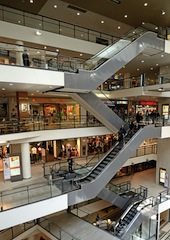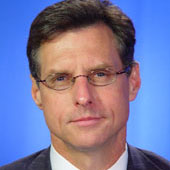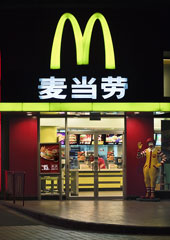The New Globalists: Malling it in Moscow
Some young, cosmopolitan expats are returning to visit Russia often. Why?
August 23, 2013

Part four of a seven part series. Return to part one or part three.
The Transformers: Leyla’s Russia
Like Bo’s China, Leyla’s Russia is nothing like the Russia her parents grew up in.
In fact, her parents and grandparents didn’t grow up in Russia but in the Soviet Union. Thus, she has a hard time relating to the Cold War and comprehending life behind the Iron Curtain.
Meet the Transformers
The Road Ahead
Coming of Age in a New China
Malling it in Moscow
The Rise of Africa
Baptized by Fire in Brazil
Dawn of the Internet in India
When her aunts speak of a life of hardship — or frequent food shortages, cold winters, dead-end jobs and the omnipotent presence of the Committee for State Security (KGB) — it all sounds foreign to Leyla because in reality, it is.
Leyla was quite young when the Soviet Union collapsed and Russia re-emerged out of the ashes of the Cold War. She has only vague memories of the difficult years following the breakup of the Soviet Union, when Russia was plunged into a near-Depression.
Many of her extended family emigrated from Russia, becoming part of a massive brain drain that would rob Russia of many of its best and brightest.
Leyla is part of the brain drain. She left the country she loves to attend college in the United Kingdom and she has never looked back, having worked in Rome, London and Barcelona over the past few years.
Brussels is now home, but Leyla does love traveling back to Moscow for a weekend of shopping with her friends.
One of her favorite stomping grounds in Russia is the Mega Belaya Dacha mall just outside of Moscow. It comes with about 250 stores, an ice-skating rink, a movie theater and carousel.
To Leyla, the place is like Disneyland, which is why Leyla and her friends can typically spend an entire day in just one mall. She is not alone.
Malls — a relative novelty in Russia — have become big business, underscoring the rise of Russia’s middle class and the nation’s new consuming cohort.
According to the International Council of Shopping Centers, Russia now has 82 malls, including the two largest in Europe. Moscow has more mall floor space than any other city in Europe.
Behind this boom is Russia’s penchant for spending, with personal consumption expenditures in Russia rising nearly eightfold between 2000 and 2011.
Russia’s personal consumption totaled a record $935 billion in 2011, a figure greater than Spain’s and that of many other developed economies in Europe, including Portugal, Ireland, Norway, Sweden and others.
Against this backdrop, it is little wonder that in the next few years, if not sooner, Russia will surpass Germany to be the largest car market in Europe. The future upside in Russia is huge given that there are now 250 cars for every 1,000 people in Russia, versus 515 cars for every 1,000 people in Germany.
Helping to boost consumer spending in Russia are the following: the nation’s flat personal income tax of 13%, socialized healthcare and the fact that many households in and around Moscow own their homes, a legacy of the post-Soviet era.
Against this backdrop, Russian consumers spend more of their pretax income on retail purchases (60%) than any other nation in Europe. Sweden ranks second, where retailing (including food purchases) accounts for 40% of total private spending. In Germany, the comparable number is 28%, reflecting the more fragile nature of the German consumer.
On a recent visit to the mall, Leyla’s mother marveled at the massive grocery store and how well the store was stocked with various meats, breads, vegetables and assorted specialty items. It was an out-of-body experience, Leyla explained, for a woman who remembers standing in bread lines and waiting in long queues for meat in the dead of winter.
Leyla knows very little about those days — her Russia is different.
She does remember, however, how special it was to visit McDonald’s for the first time when she was young. To this day she remembers waiting in line with her parents to enter the restaurant on Pushkin Square and biting into her first Big Mac.
That said, Leyla is not much into fast food these days. Her culinary tastes have been refined in the major cities of Western Europe.
However there’s plenty of pent-up demand for fast food in one of the largest economies in the world. Indeed, the Russian fast food market grew by 18% last year, and is expected to post double-digit annual average growth rates over the balance of this decade.
That is good news for U.S. food companies like McDonald’s, which now has nearly 300 restaurants in Russia, where it enjoys a 43% market share. Yum Brands has 350 restaurants in the country, with Russia among the fastest-growing markets in the world for the firm last year.
The last time we checked in with Leyla, she was headed for Warsaw for a weekend visit with friends. Getting to Warsaw from Brussels is easy and inexpensive, she explained.
The city itself is alive and thriving with teeming younger professionals from all over Central Europe. Most of the members of this cohort have only known peace and prosperity since they were born. And like Leyla, they prefer, in general, to spend rather than save, unlike their parents.
In short, it’s not just the Russian consumer that has taken to shopping. Consumerism across Russia and Central and Eastern Europe has soared over the past two decades owing to a number of variables including greater employment, rising incomes and, most of all, pent-up demand for Western goods after decades of denial.
Personal consumption in Russia and Eastern Europe doubled between 1990 and 2005 and then nearly doubled again by 2011, when expenditures totaled an impressive $2.6 trillion. That is not bad for a part of the world held under lock and key and cut off from the global markets during the Cold War.
More impressive still is this: The consumer in developing Europe is mightier than the consumer in China — a statement that runs contrary to the common narrative that China is the largest market in the world for virtually everything. That may be so, but combined personal consumption expenditures in developing Europe (Russia included) exceeded personal consumption spending in China by 4% in 2011.
In developing Europe, consumption accounted for nearly 60% of gross domestic product (GDP) in 2011. That compares to a figure of 45% in more trade-dependent Asia and less than 40% in China, using the latest figures from the United Nations (UN).
In the end, when it comes to spending, Leyla and her cohorts can give Bo and the Chinese spending class a run for their money.
Takeaways
A life of hardship sounds foreign to Leyla because in reality, it is.
Leyla is part of Russia's brain drain. She left to for school in the UK. But she returns for the shopping.
Russia now has 82 malls and Moscow has more mall floor space than any other city in Europe.
Russian consumers spend 60% of their pretax income on retail purchases, more than in any other European nation.
Consumers in all of developing Europe spent 4% more money in 2011 than Chinese consumers did.



